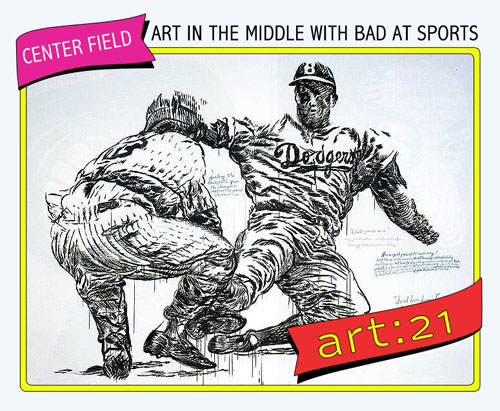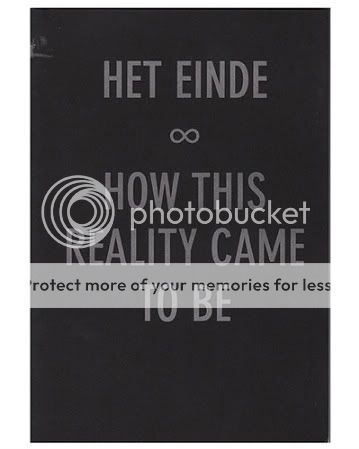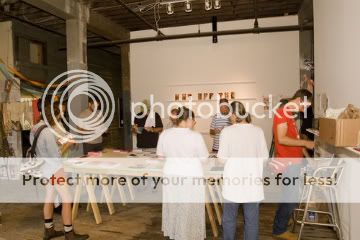When I think of Minneapolis, MN, two things typically come to mind: the first being Janet Jackson’s song “Escapade” off of her 1989 album, Janet Jackson’s Rhythm Nation 1814, where she emphatically interjects an interlude by yelling “Minneapolis!” and the second being a bit more obvious — the Walker Art Center. Although this is a bit of an exaggeration, it is meant to show how little I knew of Minneapolis or its art scene before I happened upon a back issue of Art Review & Preview (ARP!) entitled “Selective Recall: Twin Cities Art History.” The issue traced the history of the Twin Cities’ art scene. Founded by Tiff Hockin, Ariel Pate, and Troy Pieper after returning from art school in Kansas City, ARP! has supplied Minnesota with a valuable quarterly publication. This past Spring, ARP! released its final edition, “HET EINDE / HOW THIS REALITY CAME TO BE.” Ariel Pate discussed past issues, their final issue, and some offshoot projects they have been working on.
Meg Onli: The first issue of ARP! came out in the Fall of 2007. What prompted the project? What was arts writing like at the time?
Ariel Pate: ARP! was founded based on the perceived lack of a critical venue in the Minneapolis/St. Paul (Twin Cities) art community. We had originally wanted to start some kind of artist residency, but after talking to people who lived here, it seemed that an art publication would be more useful. Twin Cities art writing has been kind of an up-and-down thing. In the late 80s/early 90s, we had Artpaper, which was a big deal. Artpaper folded in 1993, conveniently preceding the rise of the Internet, which probably would have delivered the death blow anyway. After that, art writing and criticism lived on in the City Pages and other magazines, until the City Pages was Village-Voice-ized, and its competition folded.
By the time we started up, the local arts writing was primarily online at mnartists.org, a joint project of the Walker Art Center and the McKnight Foundation. There also happened to be a community of art critics, the Visual Art Critics Union of Minnesota (VACUM), who were really doing most of the art writing in the available venues. We saw that there wasn’t a reliable place for art writing in print and that when it was in print, it wasn’t very interesting. I don’t think we really knew what we were getting into. After all, we had just graduated from college.
MO: Could you talk about your interests in publications? It would have been easier to put a blog together but instead you put together a tangible object.
AP: I think we all perceived blogs as basically inconsequential—present company excepted, of course! We felt a connection between ideas and physicality. How do you save a blog? Tiff is fond of saying, “You can’t frame a wireframe and hang it on your wall…” Also, you can’t leave a blog in the bathroom as reading material, or wrap a present with it, or line a birdcage with it, or make a hat out of it, etc… Putting the paper to use in other ways makes the ideas and images in it very literally come into new contexts.
MO: I first read your publication while in a residency with a student from MCAD. He had issue #2, Selective Recall: Twin Cities Art History and I remember loving this archive and history told by the people living in its place. It was a really great place to begin when you are an outsider looking in. Did you guys think of yourself as artists archiving your scene or was it more of an intuitive process?
AP: I’m glad you picked up on that! The second issue had a pretty specific mission: to “prove” that we knew what we were talking about. When we founded ARP!, we were fresh out of college, twenty-three years old, female, and often mistaken for our own interns! It was kind of annoying that no one took us seriously, not that we totally blame them. Anyway, the second issue helped us connect to the history of the scene we wanted to be a part of, and also pointed out some assumptions that people had about their own history that were often not true. We all learn about Western art history, or even New York art history, but rarely do we take time to learn our local art history.
MO: Didn’t that issue also have a timeline of the art scene in the Twin Cities?
AP: Yep! It actually ran through the entire paper and could be assembled into an eight foot-long poster.
MO: In May you published your final issue, Het Einde / How This Reality Came to Be. For people who have not picked up the issue yet, what can they expect to find?
AP: Well, some new articles, and some reprisals of old articles. Each issue of ARP! had a theme, and though this one is generally “the End” and “the Beginning,” we wanted to point out some of the themes we’ve been addressing all along, such as: the role of art criticism locally, practically, and theoretically; and how “alternative” spaces and scenes exist here in the Twin Cities (mostly Minneapolis, really).
The highlight for me was a really nice compilation of the last “letters from the editor” of sixteen different Twin Cities publications from 1943 to present, put together by Andy Sturdevant, and followed by the eleven letters we wrote for ARP!.
In terms of format, Het Einde / How This Reality Came to Be is a 204-page paperback book. ARP! has always been a free publication (for its readers, though not necessarily for us). For our final issue, we decided to say good-bye to newsprint and adopt something a little more archival. The final issue is currently for sale on our website and at select bookstores in Minneapolis, St. Paul, Milwaukee, and Chicago (including Quimby’s! and Golden Age!)
MO: This summer, you initiated a pop-up publishing company, Hot Off The (H.O.T.) at the Soap Factory in Minneapolis. Was this a one time installation/performance/event or are you planning on more opportunities to have work published though H.O.T.?
AP: Hot Off The is definitely open-ended. But at the moment, Tiff and I are thinking about grad school. The cool thing about H.O.T. is that it’s a very flexible format—it could be at home almost anywhere. To learn more about it, check out hotoffthe.net







